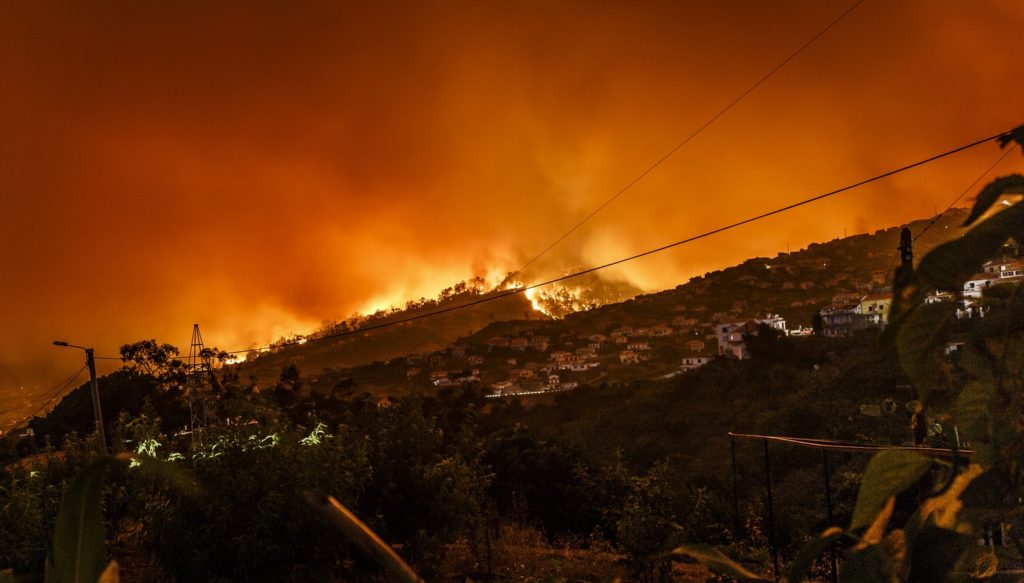This is a wildfire in Portugal, photo from Michael Held. As climate change warms temperatures, fires like this one and those in California will become more common.
Unless you live under a rock, you might have heard about IPCC (UN’s Climate Change Panel) declare that we have 12 years to get our act together, speaking in terms of our excessive Green House Gas emissions (which include carbon dioxide), before we feel extremely devastating effects of climate change. All of us.
In many cases in the world, it is typically ineffective to have either a cap-and-trade program or a carbon tax, while a hybrid which combines both works very well. Similarly, when allocating the funds from cap-and-trade and carbon tax programs, a hybrid system of earmarking money to a budget dedicated to green initiatives, and allowing citizens most affected to directly gain some of the income, is ideal. British Columbia shows how a carbon tax system can effectively distribute money to low-income/disadvantaged communities, and California shows how it can use money from carbon cap-and-trade to benefit society at large. Both have their pros and cons, and I believe a hybrid of systems such as these could have us reach our end goal of using money generated from carbon pricing to restructure society and address climate change, inequality, pollution and many other issues. Norway presents such a hybrid system which effectively allocated revenue generated from carbon pricing, but still needs tweaking to truly reduce emissions.
British Columbia has one of the most effective carbon tax systems in the world. It was the first to implement such a system in North America in 2008 (World Bank, 2014). The tax has risen $20 in its lifespan per ton of carbon, and the tax is revenue neutral, so that the money results in lower personal and business income taxes and prioritizes assisting low-income families (World Bank, 2014). As a result, British Columbia and Vancouver have had some of the lowest income taxes, as well as some of the lowest greenhouse-gas-per-capita rates in North America (World Bank, 2014). British Columbia, as of 2015, reduced 2.8 million metric tons of GHG compared to its pre-tax times, with a higher than previous GDP growth of 1.55% (Narassimhan, 2017).
British Columbia, Canada, has breathtaking views, and a strong carbon pricing system to go with them. Picture by Sarah Schimschal.
The key point here is that British Columbia defies America’s common capitalistic thread assuming that everyone is equally at risk, equally protected, and equally responsible for their circumstances. We know that this is not the case, as our discriminatory institutions make sure to keep low-income/disadvantaged communities in a position of exploitation. British Columbia makes sure to help those most at risk (those from low-income/disadvantaged communities), who will have a harder time facing the challenges posed by climate change, and most exposed to pollution and environmental hazards. This is very effective because it takes money from large corporations and gives it back to people who have benefited the least and paid most of the cost from these corporations’ profits. In this way, society is restructured, as Naomi Klein addresses in her book, “This Changes Everything”, in which she highlights how climate change and transition to renewable energy, rather than being seen as challenges which need to be addressed, can be seen as vessels with which we can restructure society completely, solving inequality and addressing climate change at the same time. I believe that this option would be most popular to those opposed to carbon pricing, because it is revenue neutral, and thus given back in the form of tax breaks. Often, conservatives who might be opposed to carbon pricing would complain that money allocated to the state might be wasted and used for the wrong reasons. But if revenue from the carbon tax is neutral, this could appease them by allowing money to go directly back to the people (but they might not agree with it helping low-income/disadvantaged communities).
California launched a carbon cap-and-trade program in 2013, and set a statewide cap on emissions from electric power plants and industrial facilities, with an emissions trading system (World Bank, 2014). This system has had a lot of pushback from the environmental justice movement because for the most part, large emitters are simply able to purchase as many permits as they wish and continue to pollute, while small businesses and entities cannot afford to pollute as much, thus paying the price for the large emitters polluting, per usual. In terms of the revenue generated from the cap-and-trade system, for the most part it is invested in renewable energy and green initiatives. These include initiatives to fund electric cars and buses; fire prevention and response; agriculture to reduce methane; urban forestry; energy efficiency; recycling and energy research (Murphy, 2017). These systems are good, and compared to most other states in the U.S., California is the greenest states due to investment in renewable energy and green initiatives. But, it has often not gotten into the hands of those who need it most. A 2016 California law requires that at least a third of investments from the cap-and-trade system must be used to benefit people living in disadvantaged and/or low-income communities, while 65% of the investments can be spent anywhere within the state (California Air Resources Board, 2018). The most disadvantaged and low-income people in California primarily live in San Joaquin Valley, in central California, and due to its agricultural nature and high rates of pollution/toxins, and these people are given priority status in needs of addressing investing money in these communities (California Air Resources Board, 2018).
While this sounds great, in reality this population is not given priority, and it is very difficult for low-income/disadvantaged communities to get money for their communities, as much of the money is distributed in competitive grants, and smaller groups often do not have the time, resources, and knowledge to apply for and gain access to them. Thus, allocating money to a larger fund to help a state with overall sustainable initiatives (fire prevention and public transportation are very important) can oftentimes benefit the small elite while offering little protection from harm for those low-income/disadvantaged communities who need it the most. California has the third largest economy in the world, and needs to set the precedence for a strong carbon pricing and revenue distribution system. Instead of investing in electric cars, which will not help our rampant problems of traffic and congestion, we need to invest in public transportation.
A road showcasing a bus of the highly effective Curitiba, Brazil, city public transportation strategy. Photo by Lucas Versolato.
I would love to see a transition to a sustainable bus system like in the case of Curitiba, Brazil, a city which predicted economic growth and planned accordingly. Since there were already many roads and infrastructure in place for buses, they made their buses similar to metro/subway systems. They are high speed, and owned by different businesses who are allocated the best bus lines dependent on their customer service so that they run effectively (Reed, 2015). Additionally, the bus terminals have people pay before they enter the station like a metro, so that the process moves faster, and the bus doors completely open so that more than one person can enter at a time. California, rather than investing in electric cars and high speed metro/rail (which are both very expensive and take their own resources to implement), needs to invest instead in electric buses. We already have the infrastructure for buses, but they are not as effective as they need to be. Buses need to have their own lane, and we need to incentivize people to use the bus such as making the fare affordable, like in Curitiba where it is based on income. We also need to incentivize people to take public transit, like for example by having commute time on the bus paid for as work time by companies, such as in the Netherlands with commute time by bike. Investment in bike transportation would be extremely helpful as well, with bikes having their own lanes so that it is safe without fear of getting hit, larger room on buses for storing bikes and safe bike garages where people can leave their bikes before/after getting on/off the bus. This way, people would be much healthier and rely less on fossil fuels or electricity energy sources.
Norway shows us how a hybrid system, EU ETS (the EU’s cap-and-trade system) combined has potential to generate revenue and reduce emissions. Norway has used its revenue to reduce taxes, and established a pension fund with $80,000 for every Norwegian, at the end of 2007 (Narassimhan, 2017). In Norway in 2013, 30% of carbon tax revenue was earmarked for green spending for the “Green Fund for Climate, Renewable Energy and Energy Efficiency Measures”, and the remaining 70% was allocated to the general budget (Narassimhan, 2017). The Green Fund helped to implement a great deal of sustainable infrastructure and renewable public transportation. Although this is very good on end of revenue generation and allocation, Norway’s overall emissions were not significantly reduced with this hybrid system, because while oil is taxed under the carbon tax, natural gas was not, allowing it become much more prevalent, and emissions actually rose.
Norway has a great way of allocating revenue from its carbon pricing, but needs to work on actually reducing emissions. Photo by Robert Bye.
So, taking what we have seen from the benefits of a carbon tax system in BC to help low-income/disadvantaged communities, California’s good green state initiatives, and Norway’s hybrid system which created great income for its citizens while providing money for a green fund to revolutionize its society, we must take the benefits of each system to create one which encompasses social justice, renewables/green energy to fight climate change, and a restructuring of societies everywhere into a green and sustainable realm. At this point, Norway’s revenue allocation system is ideal, combined with BC’s carbon tax system and California’s investments in green energy and initiatives.
References
California Air Resources Board. (2018). Priority Population Investments. Retrieved from https://www.arb.ca.gov/cc/capandtrade/auctionproceeds/communityinvestments.htm
Johnson, Nathanael. (2018). California makes big money from its carbon pricing program. Who gets it? Grist. Retrieved from https://grist.org/article/california-makes-big-money-from-its-carbon-pricing-pro
Murphy, Katy. (2017). Here’s how California plans to spend $1.5 billion in cap-and-trade money. Mercury News. Retrieved from https://www.mercurynews.com/2017/09/12/heres-how-california-plans-to-spend-1-5-billion-in-cap-and-trade-money/
Narassimhan, E., Gallagher, K. S., Koester, S. and Rivera Alejo, J. (2017). Carbon Pricing in Practice: A Review of the Evidence. Medford, MA. Climate Policy Lab. Retrieved from https://sites.tufts.edu/cierp/files/2017/11/Carbon-Pricing-In-Practice-A-Review-of-the-Evidence.pdf
Reed, Drew. (2015). How Curitiba’s BRT stations sparked a transport revolution – a history of cities in 50 buildings, day 43. The Guardian. Retrieved from https://www.theguardian.com/cities/2015/may/26/curitiba-brazil-brt-transport-revolution-history-cities-50-buildings
World Bank. (2014). What Does Carbon Pricing Success Look Like? Ask These Leaders. Retrieved from http://www.worldbank.org/en/news/feature/2014/09/18/what-does-carbon-pricing-success-look-like-ask-the-leaders





